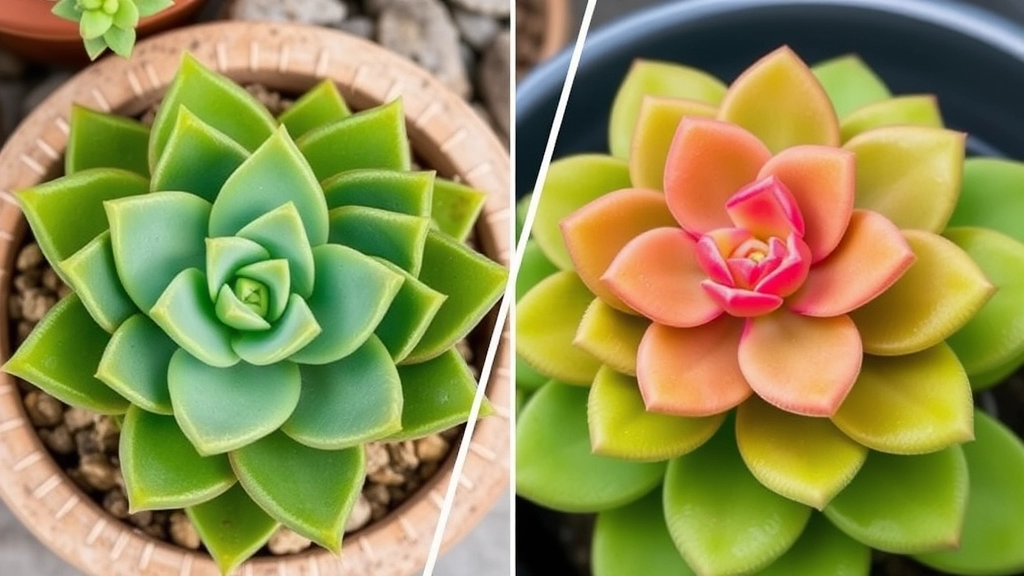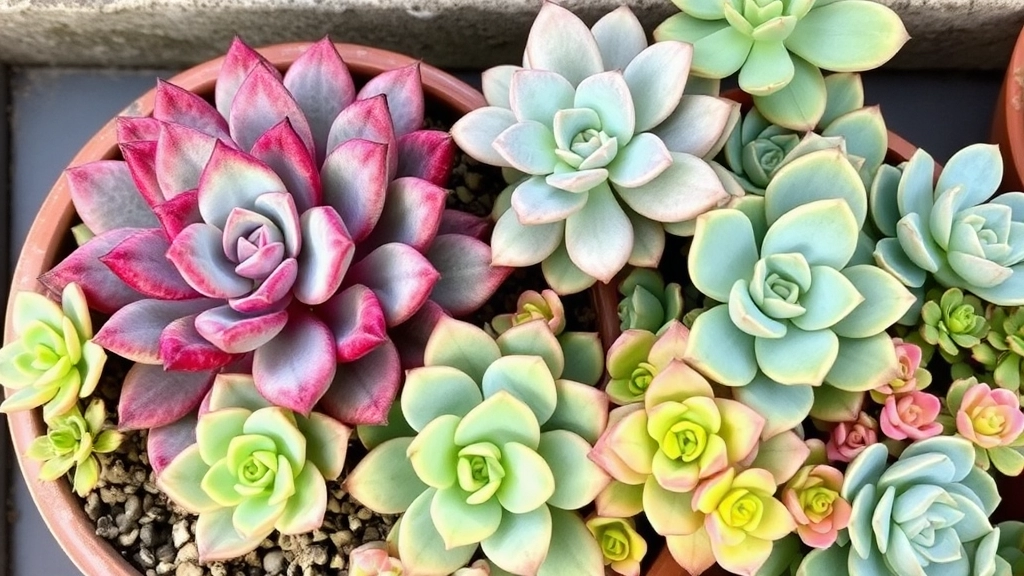Euphorbia and Kalanchoe Succulents
When it comes to Euphorbia succulents and Kalanchoe succulents, understanding their unique characteristics and care requirements can significantly enhance your gardening experience. Both genera boast a variety of species that are perfect for both indoor and outdoor cultivation, making them popular choices among succulent enthusiasts.
In this article, we’ll explore some of the most beloved Euphorbia and Kalanchoe species, highlight their key differences, and provide essential tips on how to grow and care for them. Whether you’re looking to add a touch of greenery to your home or create a stunning garden display, knowing how to properly care for these succulents will ensure they thrive and bring beauty to your space.
Popular Euphorbia and Kalanchoe Species for Gardens
When considering the ideal plants for your garden, you might find yourself wondering which succulents to choose. Euphorbia and Kalanchoe are two popular options, each bringing unique beauty and resilience to outdoor spaces.
Popular Euphorbia Species
Euphorbia is a diverse genus, with many species that thrive in various climates. Here are a few standout options:
- Euphorbia milii (Crown of Thorns): This hardy plant features vibrant flowers and thorny stems, making it a striking choice for borders or containers.
- Euphorbia tirucalli (Pencil Cactus): Known for its tall, upright growth and unique pencil-like stems, this succulent adds height and interest to any garden design.
- Euphorbia polygona (African Milk Barrel): With its geometric shape and striking green and white patterns, this species is a conversation starter in any succulent arrangement.
Popular Kalanchoe Species
Kalanchoe is equally captivating, offering a range of colours and forms. Here are some popular varieties:
- Kalanchoe blossfeldiana (Flaming Katy): This succulent is famous for its bright clusters of flowers, perfect for adding a splash of colour to your garden.
- Kalanchoe tomentosa (Panda Plant): With its fuzzy, silvery leaves, this species brings a soft texture that contrasts beautifully with other plants.
- Kalanchoe luciae (Paddle Plant): Known for its large, paddle-shaped leaves that turn a stunning red in bright sunlight, this plant is a visual delight.
Incorporating these Euphorbia and Kalanchoe species can elevate your garden’s aesthetic, creating a vibrant and diverse landscape.
Key Differences Between Euphorbia and Kalanchoe Succulents

So, you’re diving into the world of succulents and wondering what sets Euphorbia and Kalanchoe apart?
Let’s break it down simply.
1. Botanical Family
- Euphorbia belongs to the Euphorbiaceae family.
- Kalanchoe is part of the Crassulaceae family.
2. Appearance
- Euphorbia can be quite diverse. Some look like cacti, while others resemble leafy plants.
- Kalanchoe usually has thick, fleshy leaves and vibrant flowers. Think of those lovely clusters of blooms!
3. Growth Habit
- Euphorbia often grows upright and can become quite tall.
- Kalanchoe tends to be bushier and more compact, making it perfect for smaller spaces.
4. Flowers
- Euphorbia flowers are often less showy, sometimes resembling small, unassuming clusters.
- Kalanchoe is known for its stunning, colourful flowers that can brighten up any garden.
5. Toxicity
- Euphorbia can be toxic if ingested, so keep it away from pets and kids.
- Kalanchoe can also be toxic, but it’s generally less harmful compared to Euphorbia.
6. Water Needs
- Euphorbia prefers drier conditions and can tolerate drought better.
- Kalanchoe likes a bit more moisture but still thrives in well-draining soil.
When considering the best conditions for growing Euphorbia succulents, many gardeners often wonder about their specific needs.
Euphorbia species thrive in environments that mimic their native habitats, which are often arid and sunny. Here are the key requirements:
– **Light**: Euphorbia succulents prefer bright, indirect sunlight. A south-facing window is ideal for indoor plants, while outdoor varieties flourish in full sun. However, be cautious of intense afternoon sun, which can scorch the leaves.
– **Soil**: Well-draining soil is essential. A cactus mix or a homemade blend of potting soil and sand works well. This ensures excess water drains away quickly, preventing root rot.
– **Watering**: Less is more. Water only when the top inch of soil feels dry. During the growing season (spring and summer), this may be once every two weeks, while in winter, reduce to once a month or less.
– **Temperature**: Euphorbia succulents prefer warm temperatures, ideally between 21°C to 27°C (70°F to 80°F). They can tolerate cooler temperatures but should be protected from frost.
– **Humidity**: These plants thrive in low humidity environments. High humidity can lead to fungal issues, so ensure good air circulation around your plants.
By understanding these ideal conditions, you can effectively cultivate healthy Euphorbia succulents in your garden or home. For more detailed care tips on similar plants, check out this [ultimate guide to growing and caring for succulent plant Kalanchoe](https://planthq.org/ultimate-guide-to-growing-and-caring-for-succulent-plant-kalanchoe/) and learn about [top flowering Kalanchoe species and care tips](https://planthq.org/top-flowering-kalanchoe-species-and-care-tips/).
How to Care for Kalanchoe Succulents Indoors and Outdoors

Caring for Kalanchoe succulents is essential for their vibrant growth and longevity. Whether you’re nurturing them indoors or outdoors, understanding their needs can make all the difference.
Indoor Care for Kalanchoe
When growing Kalanchoe indoors, consider the following:
- Light: Place your Kalanchoe in a spot that receives bright, indirect sunlight. A south-facing window is ideal.
- Watering: Allow the soil to dry out completely between waterings. Typically, watering every 2-3 weeks is sufficient.
- Soil: Use a well-draining potting mix designed for succulents. This helps prevent root rot.
- Temperature: Maintain indoor temperatures between 15-25°C. Avoid placing them near drafts or heating vents.
Outdoor Care for Kalanchoe
For outdoor Kalanchoe, the approach varies slightly:
- Light: Choose a location with full sun to partial shade. They thrive in bright conditions.
- Watering: Water deeply but infrequently. Ensure the soil dries out before the next watering.
- Soil: Similar to indoor care, use well-draining soil. Raised beds or pots can enhance drainage.
- Temperature: Kalanchoe can tolerate warmer temperatures but should be protected from frost.
Common Challenges
While caring for Kalanchoe, you may encounter some challenges:
- Overwatering: This is a common issue that leads to root rot. Always check the soil moisture before watering.
- Pests: Watch for mealybugs and aphids. Regularly inspect the leaves and treat infestations promptly.
Potential Challenges: Common Pests and Diseases in Euphorbia and Kalanchoe
As we delve into the care of Euphorbia and Kalanchoe, it’s essential to consider the potential challenges these beautiful succulents may face.
Common Pests
Both Euphorbia and Kalanchoe can attract pests that may threaten their health. Here are some of the most common culprits:
- Mealybugs: These small, white insects often hide in the leaf axils and can cause significant damage by sucking sap.
- Spider Mites: Tiny and often hard to see, spider mites can lead to stippled leaves and webbing on the plant.
- Aphids: These pests can be found on new growth, causing distortion and stunted growth.
Diseases to Watch For
In addition to pests, diseases can also pose a risk:
- Root Rot: Overwatering is a leading cause of root rot, especially in Euphorbia. Ensure pots have proper drainage.
- Powdery Mildew: This fungal disease appears as a white powder on leaves, often due to high humidity and poor air circulation.
Prevention and Treatment
To keep your Euphorbia and Kalanchoe thriving, consider these preventive measures:
- Regular Inspections: Check your plants weekly for signs of pests or disease.
- Proper Watering: Water only when the soil is dry to prevent root rot.
- Good Airflow: Position your plants to allow for adequate airflow, reducing humidity and the risk of fungal diseases.
If you encounter any issues, prompt action is crucial. Use insecticidal soap for pests or remove affected leaves to control the spread of diseases. For more detailed care tips, you can refer to our ultimate guide to caring for Kalanchoe succulents. Additionally, for specific advice on dealing with leaf issues, check out our Kalanchoe Blossfeldiana leaf care tips.
Landscaping Ideas Using Euphorbia and Kalanchoe Together
So, you’re thinking about how to jazz up your garden with Euphorbia and Kalanchoe? You’re in the right spot! These two succulents can create stunning landscapes that not only look good but are also low-maintenance.
1. Mix and Match for Colour Contrast
Euphorbia often boasts striking green foliage with vibrant flowers, while Kalanchoe brings a splash of colour with its varied blooms.
- Pairing Ideas:
- Use Euphorbia’s tall, spiky forms as a backdrop for the low, bushy Kalanchoe.
- Try Kalanchoe in shades of pink or yellow against the deep greens of Euphorbia.
2. Create a Succulent Border
Want to define spaces in your garden?
- Border Idea:
- Plant Euphorbia as a tall border along pathways, and fill in the front with a colourful row of Kalanchoe.
- This not only adds structure but also draws the eye to different areas of your garden.
3. Rock Gardens and Containers
Rock gardens are perfect for these succulents.
- Design Tips:
- Use Kalanchoe in pots or raised beds for a pop of colour.
- Incorporate Euphorbia among the rocks for a natural look.
- Mix in gravel or pebbles to enhance drainage and keep the look clean.
4. Seasonal Displays
Why not change things up with the seasons?
- Seasonal Ideas:
- Use Kalanchoe to attract butterflies and bees.
- Use Euphorbia as a shelter for small critters.
5. Wildlife-Friendly Gardens
Want to attract pollinators?
FAQs on Euphorbia and Kalanchoe Succulents
What are the main differences between Euphorbia and Kalanchoe succulents?
Euphorbia belongs to the Euphorbiaceae family and can look like cacti or leafy plants, while Kalanchoe is part of the Crassulaceae family and typically has thick, fleshy leaves with vibrant flowers.
How do the growth habits of Euphorbia and Kalanchoe differ?
Euphorbia often grows upright and can become quite tall, whereas Kalanchoe tends to be bushier and more compact, making it suitable for smaller spaces.
Are Euphorbia and Kalanchoe succulents toxic?
Yes, both can be toxic. Euphorbia is generally more toxic if ingested, so it should be kept away from pets and children. Kalanchoe is also toxic but is generally less harmful compared to Euphorbia.
What kind of water needs do Euphorbia and Kalanchoe have?
Euphorbia prefers drier conditions and can tolerate drought better, while Kalanchoe likes a bit more moisture but still thrives in well-draining soil.
How should I care for Kalanchoe succulents indoors?
Place your Kalanchoe in bright, indirect sunlight, allow the soil to dry out completely between waterings, use a well-draining potting mix, and maintain indoor temperatures between 15-25°C.
What are the care tips for Kalanchoe succulents outdoors?
For outdoor care, choose a location with full sun to partial shade, water deeply but infrequently, use well-draining soil, and protect the plant from frost.
What are common challenges when caring for Kalanchoe succulents?
Common challenges include overwatering, which leads to root rot, and pests like mealybugs and aphids. Regularly inspect the leaves and treat infestations promptly.
References
-
Euphorbia Succulents: Types, Care, and Maintenance
-
How to Grow and Care for Kalanchoe
-
Kalanchoe: Plant Care & Growing Guide
